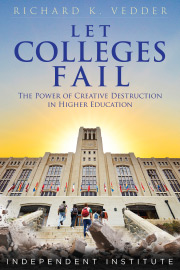Almost one-quarter of a millennium ago, at the very same time James Watt was inventing the steam engine, the Irish novelist and poet Oliver Goldsmith wrote “The Deserted Village,” a poem despairing the alleged depopulation of rural communities as the Industrial Revolution and urbanization proceeded. A thought occurred: history is repeating itself. We are having increased “depopulation” of some academic villages--universities--as potential scholars flee to other more promising communities of scholars, or to the workplace.
Almost every week there is some manifestation of the academic version of Goldsmith’s story. Recently, Western Illinois University (WIU) announced the layoff of 24 faculty members, some tenured. Another 62 unfilled positions are also being eliminated. This is not the first downsizing at WIU, nor will it probably be the last. In 2013, 11,700 students attended WIU. News reports suggest only 8,000 or so will enroll this fall, a decline of more than 30% in five years.
Two hundred fifty miles southeast of WIU’s campus, Southern Illinois University is facing very tough times, leading to a near civil war between its two largest campuses at Carbondale and Edwardsville. At the flagship Carbondale campus, more than 24,000 students attended a generation ago, in 1990; last fall, enrollment was under 15,000 and still falling. In Illinois’s leading city, enrollment at Chicago State University has fallen precipitously, seemingly asymptotically approaching zero.
One might assume this is all a consequence of Illinois’s dysfunctional state government, which has sharply reduced its support of the schools cited above. But it is a national phenomenon. A seven-hour car ride northeast from WIU’s Macomb campus brings you to the home of Eastern Michigan University (EMU). Enrollment, more than 25,000 in 1990, is around 21,000 today. A few hours drive to the southeast, at the University of Akron, enrollment fell from almost 30,000 in 2011 to 23,114 in 2016, a decline of more than 20% in five years.
The enrollment declines have been particularly acute in the industrial Midwest, but noticeable elsewhere as well. To cite one example, the spring 2018 enrollment at the University of Central Oklahoma was 14,313, down more than 10% from four years earlier. Facing high fixed costs and relatively stagnant or sometimes falling state support, enrollment declines mean the loss of vital tuition revenues, forcing schools to adopt previously politically unacceptable forms of change (e.g., firing tenured professors) in order to survive.
Yet amidst these declines, often even more dramatic at community colleges, highly selective admission universities’ enrollments are at record highs and their problem is not attracting students but rather deciding whom to turn away. The flagship state schools in Illinois, Michigan, and Ohio, for example, are easily achieving their enrollment goals, as are the most prestigious and expensive private elite schools nationwide. The gap between the generally wealthier top and usually poorer bottom schools is widening sharply.
Why? A large part of the reason relates to the fact that college degrees are becoming less effective as screening devices, information helping employers separate the likely most productive, bright and disciplined prospective workers from others. When nearly everyone has some sort of post-secondary credential and posts high grades (because of grade inflation), a degree from Harvard or the University of Michigan still is highly respected, so their graduates mostly get decent jobs. That is distinctly less true of those graduating from less selective schools.
The imperfect but still useful College Scorecard website of the U.S. Department of Education tells us that average earnings after attending the U of M are $60,100, and 90% of students do graduate (within six years). By contrast, at EMU, seven miles away, average earnings are nearly 38% less ($37,500), and only38 % actually graduate. And the tuition at U of M, for the typical in-state student, is only a bit more expensive. No wonder students are clamoring to get into the schools perceived to be the best, and losing interest in less selective schools.
The basic problem is that colleges actually impart directly employable skills for only a very modest portion of the college population (such as engineering and accounting majors) and that employers hiring high paid workers feel they need someone with more than a degree from the College of Last Resort. I do not see this trend changing much soon to help the Western Illinois and Eastern Michigans of the world.














